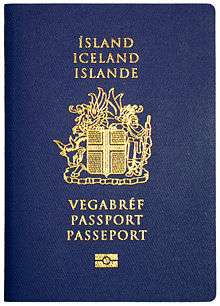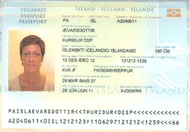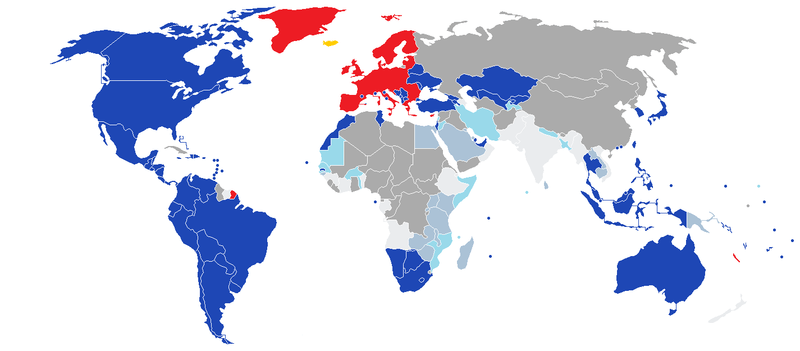Icelandic passport
Icelandic passports are issued to citizens of Iceland for the purpose of international travel. The passport allows for freedom of movement in any of the states of the European Economic Area and Switzerland.
| Icelandic passport | |
|---|---|
 The front cover of a first-generation Icelandic biometric passport issued from 2006–2019 | |
 The biodata page of an Icelandic biometric passport | |
| Type | Passport |
| Issued by | |
| First issued | 1 June 1999 (machine-readable passport) 23 May 2006[1] (biometric) 1 February 2019 (current version) |
| Purpose | Identification |
| Eligibility | Icelandic citizenship |
| Expiration | 10 years from date of issue (adults, 2018) |
| Cost | 13000 ISK (adults aged 18–66 years; regular application) 26000 ISK (adults aged 18–66 years; urgent application) 5600 ISK (children below 18 years, elderly aged 67 years and above, disabled people; regular application) 11000 ISK (children below 18 years, elderly aged 67 years and above, disabled people; urgent application)[2] |
History
A new design was put into circulation in May 1987.[3] It featured a dark blue (near-black) cover, laser-printed pages, and a laminated information page.
The first machine-readable Icelandic passports were introduced on 1 June 1999,[4] having a blue cover, a machine-readable strip and improved security features. A hard-plastic page with a biometric chip was added in May 2006,[5] and the validity was temporarily shortened from ten years to five. In June 2013, the chip was relocated to the back cover and the validity restored to ten years.[5]
A new Icelandic passport design was introduced on 1 February 2019, featuring a slightly enlarged Icelandic coat of arms and sans-serif wording on the front cover.[6]
Physical Appearance
Icelandic passports are blue, with the Icelandic coat of arms emblazoned in the centre of the front cover. The words "ÍSLAND" (Icelandic), "ICELAND" (English) and "ISLANDE" (French) are inscribed above the coat of arms and the words "VEGABRÉF" (Icelandic), "PASSPORT" (English) and "PASSEPORT" (French) are inscribed below the coat of arms. Icelandic passports have the standard biometric symbol at the bottom.[7]
Vegabréf literally means "road letter", a word historically used in Scandinavia meaning internal passport.
Identity Information Page

The Icelandic passport includes the following data:
- Photo of Passport Holder
- Type (PA)
- Code (ISL)
- Passport No.
- Surname
- Given Names
- Nationality
- Height
- Date of Birth
- Personal code number
- Sex
- Place of Birth
- Date of Issue
- Date of Expiry
- Authority
The information page ends with the Machine Readable Zone.
Different spellings of the same name
Personal names containing the special Icelandic letters (ð, þ, æ, ö) are spelled the correct way in the non-machine-readable zone, but are mapped in the machine-readable zone. ð becomes D, þ becomes TH, æ becomes AE, and ö becomes OE.
Letters with accents are replaced by simple letters (e.g., é → E). This follows the standard for machine-readable passports.
Visa free travel

Visa requirements for Icelandic citizens are administrative entry restrictions by the authorities of other states placed on citizens of Iceland. As of 3 April 2020, Icelandic citizens had visa-free or visa-on-arrival access to 180 countries and territories, ranking the Icelandic passport 11th in the world in terms of travel freedom (tied with Latvian and Slovenian passports) according to the Henley Passport Index.[8] Moreover, by virtue of Iceland's membership of the European Economic Area, they can travel to 28 European Union member states, Norway, Liechtenstein, and Switzerland to live and work as long as they wish.
Other identity documents
Inside Iceland and the other Nordic countries, an Icelandic identity card or driving licence is usually sufficient for personal identification. They do not state citizenship and therefore are not usable in most cases as travel documentation outside of the Nordic countries. The Icelandic identity card is called "Nafnskírteini" ("name certificate"). Most people do not have it and use driving licences instead.
External links
References